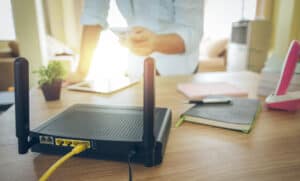
There are several reasons you might want to access your home network when you’re away from home. Whether it is to have access to essential files on your home computer, monitor your kids’ activity on the computer, or investigate if your neighbors are using your Wi-Fi when you’re away, the reasons are endless.
You can access your home network remotely by manually turning on the remote management feature on your home router. You should also set up dynamic DNS to tackle the dynamic public IP address problem. Other options include a remote access VPN, third-party apps like “TeamViewer”, or a “Remote Desktop”.
In this article, we discussed four ways that we can access our home network remotely. We also explained the pros and cons of some of the methods to help you make the best decision.
Method #1: Allowing Remote Management on Your Home Router
When you’re at home, accessing your router is pretty much straightforward. All you have to do is input your home router’s IP address in a web browser. However, to access the router remotely, you must type the public IP address followed by your remote control port number, usually 8080 by default.
Your router’s remote management feature is always turned off for security purposes. To turn it on, follow the steps below.
- Type your home router’s IP address in your web browser.
- Enter your username and password. Ensure it is a strong password to prevent hackers from gaining access to your network.
- After gaining access to the router’s web portal, open “Settings” or “Tools”.
- Find the “Remote Management” or “Remote Access” option.
- Enable “Remote Management”.
Your router’s remote access was turned off by default for security reasons. When you enable it, ensure that you take the necessary steps to make your home network secure. You can do the following. - Change your default port number from 8080 to another number.
- Use a strong Admin password instead of the default login.
Enabling remote access is only the first step. Since your home network is assigned a dynamic public IP address, it will keep changing. This might not be a cause for concern when you’re at home because you can always check the new public IP address on your home computer.
However, to access the network remotely, you can’t afford to have a public IP address that keeps changing since you can’t find the new IP address from a remote location. This is where Dynamic DNS (DDNS) comes in. In summary, by signing up with DDNS, you link your dynamic public IP address to a fixed domain name.
The fixed domain name can then be used in place of your dynamic public IP. DDNS also constantly updates any changes in the public IP, but the fixed domain name remains the same. Knowing the fixed domain name makes it easy to access your home address remotely.
Method #2: Using Remote Access Virtual Private Network (VPN)
VPN enables you to access your home network remotely and use it as if you were there. Follow the steps below to set it up.
- Ensure that your home router has an integrated “VPN” functionality.
- Log in to the back-end “Admin Panel” of your router on your home computer.
- Go to software settings and enable “VPN” functionality.
- Turn on “Remote Access” or “Remote Management”.
- Create a user account for your remote computer and install VPN software on the computer.
- Go to the “Control Panel” on your remote computer and open “Network and Sharing”.
- Select “Create a New Connection”.
- Choose the appropriate VPN and enter your home router’s IP address.
- The remote computer can now access the home network.
Alternative Steps for Macbook
Steps 6, 7, and 8 above are applicable for Windows computers. For Apple computers, please follow these steps.
- Go to the Apple menu on your remote computer and open “System Preferences”.
- Click “Network” and select “Add” at the bottom of the network services connection list.
- Choose the appropriate VPN from the menu and enter your home router’s IP address.
Method #3: Using Third-Party Apps Like TeamViewer
TeamViewer is perfect for accessing your home network from a remote location. To set it up, all you have to do is follow the steps below.
- Ensure the latest version of TeamViewer is installed on both the remote and home computers.
- Log in to the “TeamViewer App” on your home computer.
- Go to “Extras” at the top of the application page and select “Options”.
- Go to the “Security” tab and input a personal password.
- Go to the “Remote Access” tab to view and note down “Your ID”.
- Log in to TeamViewer on the remote computer.
- Go to the “Remote Access” tab.
- Click on “Add Computer”.
- Enter the ID you noted earlier and the personal password you created.
- Click “OK” to complete the connection. You can now access your home computer from your remote computer.
Method #4: Using Remote Desktop
Remote Desktop is a built-in function that allows you to connect your remote computer to your home computer and control it as if it were in front of you. Remote Desktop is a common feature used by technicians who take over your computer from a remote location and help you fix it.
To use Remote Desktop, follow the steps below.
- Turn on both the remote device and the home computer.
- Go to “Settings” on your home computer and click on “System”.
- Click to enable “Remote Desktop”.
- On your remote computer, type “Remote Desktop Connection” in the search bar.
- Select “Remote Desktop Connection”.
- Input the name of the home computer.
- Click “Connect”.
Conclusion
Now that you’re armed with this knowledge, you won’t have to rush back home whenever you forget to copy important documents from your home laptop to your work laptop. You can try these methods and retrieve all the files you need remotely.








